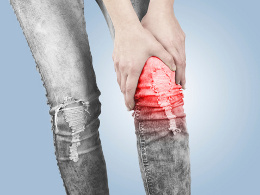Sprained knee is not a very serious injury; however, it is definitely painful. It may occur due to a number of reasons. This article discusses the causes, symptoms, and treatment options to deal with this pain.

A knee sprain occurs when one or more ligaments in the knee get overstretched or ruptured due to a sudden twist or a pull. Ligaments are those tissues which hold the bones together. Sprains are a common occurrence during sports activities, and their severity may vary from a slight stretch to a complete tear of the ligament.
Causes
Sprains are often caused due to movements which are not normal for the knee. One such commonly observed movement during sports is to plant the foot on the ground and quickly turn at the knee. Other movements include walking, running and halting, suddenly stopping to change the direction, jumping up and down, etc.
Another cause is hyperextending the knee, which means, straightening the leg more than its normal range of motion. Direct hits either to the front or back side of the knees, tripping or falling down on the knees when they are bent, etc may also lead to a sprain in the knee.
Symptoms
The very first symptom which is observed is decreased movement of the knee. The person may experience stiffness in the knee and may find it difficult to move. Another symptom is pain or tenderness in the affected area. Some people may also feel or hear a painful "pop" in the knee while some may experience that the knee buckles or gives out when they try to walk. Joint swelling and bruising may occur in the first few hours after the sprain. This is because the ligament bleeds into the knee-joint.
Treatment
The treatment involves the use of measures to control the pain and swelling of the knee joint. It is important to give ample rest to the affected knee. Therefore, you should avoid walking since the impact of your weight on the affected knee may aggravate the pain. This may help reduce the swelling and provide sufficient time to recover from the sprain.
Using ice packs on the affected knee may help decrease the swelling, pain, and redness since the blood vessels are constricted. Use of frozen corn or peas may also give the same effect as that of an ice pack. The ice pack may be applied on the affected area for 15-20 minutes, about 3-4 times a day. This treatment may be used for 3-4 days until the pain goes away. However, do not sleep with the ice pack on the injured area since it may cause frostbite.
Compress, or an elastic bandage, wrapped around the knee may prevent it from moving too much during its recovery period. Also, it should not be wrapped too tight or too loose. In other words, it should be wrapped comfortably. Placing the knee on an elevated platform may also help reduce the swelling.
If the pain is unbearable, non-steroidal anti-inflammatory medicines may be taken; however, it is recommended to take these medicines only after consulting your health care professional. In case there is extra fluid accumulation in the injured knee, it may have to be drained out. Draining out the fluid may help in the healing process. Exercises may be prescribed after the initial swelling and inflammation has decreased. These exercises may help strengthen and stretch the knee. However, it is better to consult a physical therapist, and not start any exercises on your own.
The recovery time depends on the type of injury caused to the knee. In very rare cases, surgical intervention may be required. In such a case, the recovery time may certainly be much more. If treatment at home doesn't work, then it is better to visit a physician to rule out any other complications.
Disclaimer:
This Buzzle article is for informative purposes only, and should not be used as a replacement for expert medical advice.


 A knee sprain occurs when one or more ligaments in the knee get overstretched or ruptured due to a sudden twist or a pull. Ligaments are those tissues which hold the bones together. Sprains are a common occurrence during sports activities, and their severity may vary from a slight stretch to a complete tear of the ligament.
A knee sprain occurs when one or more ligaments in the knee get overstretched or ruptured due to a sudden twist or a pull. Ligaments are those tissues which hold the bones together. Sprains are a common occurrence during sports activities, and their severity may vary from a slight stretch to a complete tear of the ligament.